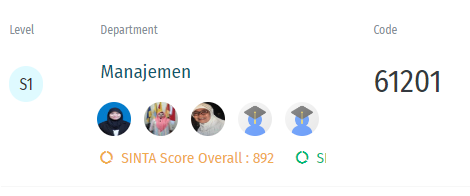Efektivitas Implementasi Program Keluarga Berencana Dalam Menekan Laju Pertumbuhan Penduduk di Kabupaten Pulau Morotai Tahun 2017-2021 (Studi Kasus Kecamatan Morotai Selatan)
Keywords:
Implementation of the Family Planning Program, Population Growth RateAbstract
The aim of the research is to determine the effectiveness of the family planning program in reducing the rate of population growth in Morotai Island Regency (case study of South Morotai District), to determine the implementation of the family planning program in reducing the rate of population growth in Morotai Island Regency (case study of South Morotai District). This research uses a descriptive method with a qualitative approach. The descriptive method is research that aims to provide an overview of a particular society or group regarding a symptom or phenomenon. The results of this research are that the family planning program in South Morotai District is quite effective in suppressing the rate of population growth, this can be seen from several indicators used to measure the effectiveness of the family planning program, namely from program targets, outreach from technical services, to analysis of the achievements of the family planning program. , Indicators in measuring the effectiveness of the policy are reflected in the program targets, in this case, couples of childbearing age (PUS), where the percentage of women's awareness is increasing, but the socialization of the program is carried out in order to provide understanding to the public about the purpose and importance of implementation. The family planning program is less effective. Judging from the objectives of implementing the family planning program, it shows that there is a decrease in fertility levels in South Morotai District. This can be seen from the last 5 (five) years of a decline in population figures in South Morotai District.References
Bagoes Mantra, Ida. 2009. Demografi Umum. Cet. VIII; Yogyakarta: Pustaka Pelajar.
Bungin, Burhan. 2015. Metodologi Penelitian Sosial & Ekonomi. Cet. II; Jakarta: Predanamedia Graoup.
Budi Winarno. 2008. Kebijakan Publik Teori dan Proses. Cet II; Yogyakarta : MedPress.
Mukani, Miswani Syuaib. 2011. Pelayanan Keluarga Berencana. Cet. 1; Makassar: Alauddin University Press.
Munir, Rozi, Dan Priyono Tjiptoheriyanto. 1986. Penduduk Dan Ekonomi. Cet. II; Jakarta: PT. Bina Aksara,.
Smith, Stephen, Michael P. Todaro. 2006. Pembangunan Ekonomi Edisi Sembilan. Jakarta: Erlangga.
Tirtosudarno, Riwanto. 1996. Demografi Politik Pembangunan Indonesia Dari Riau Sampai Timor-Timur. Cet. I; Jakarta: Pustaka Sinar Harapan..
Fitri, Efektifitas Program Keluarga berencana dalam menekan laju pertumbuhan penduduk di kota Makassar 2018
Mardiyanto. Pemberdayaan Keluarga Melalui Kampung KB Dalam Upaya Peningkatan Program KKBPK Dan Terkait Di Jawa Timur. Jurnal Keluarga. Vol 2. No. 1. 2017
Merrynce Dan Ahmad Hidir. “Efektivitas Pelaksanaan Program Keluarga Berencana”. Jurnal Kebijakan Publik. Vol 4 No. 1. 2013.
Nurjana, Efektifitas Program Keluarga berencana dalam menekan laju pertumbuhan penduduk di kota Makassar 2019
Pasra, dkk. “Efektivitas Program Keluarga Berencana Dalam Menekan Laju Pertumbuhan Penduduk Di Kota Riau”. Jurnal Jom Fekom. Vol 1. No 2. 2014.
Rahma, Merita. “Pengendalian Pertumbuhan Penduduk Melalui Pelaksanaan Program KB/TBKB”. Skripsi. Bandar Lampung Fakultas Ilmu Sosial Dan Ilmu Politik. 2016.
Suartha, Nyoman. Faktor-Faktor Yang Mempengaruhi Tingginya Laju Pertumbuhan Penduduk Dan Implementasi Kebijakan Penduduk Di Provinsi Bali. Jurnal Piramida. Vol XII, No. 1. 2016. Sulistiyawati, Ari. Pelayanan
Demografi, Lembaga. 2016. Dasar-Dasar Demografi. Cet. V; Jakarta: Salemba Empat.
Direktorat Jenderal Anggaran Kementrian keuangan. 2015. kajian kependudukan.
Keluarga Berencana. Cet. II; Jakarta: Salemba Medika. 2012.
Republik Indonesia. Undang-Undang RI Nomor 10 Tahun 1992. Perkembangan Kependudukan Dan Pembangunan Keluarga Sejahtera, Dalam UndangUndang Keluarga Berencana. Bagian II. Pasal: Jakarta. 1992.
Republik Indonesia, Undang-Undang RI Nomor 52 Tahun 2009 Tentang Perkembangan Kependudukan Dan Pembangunan Keluarga. Bab I Pasal I. 2009.









